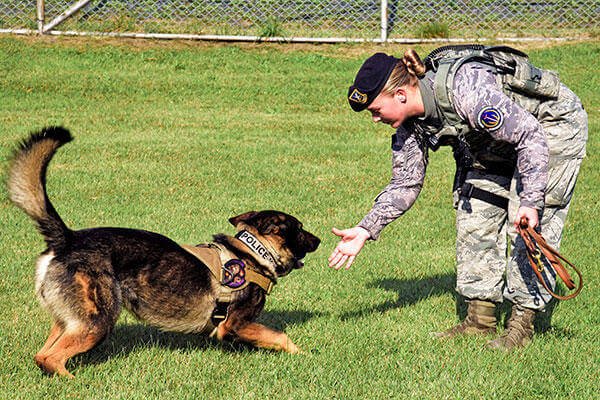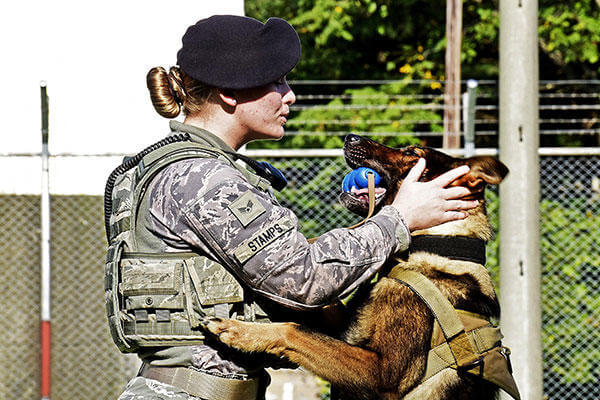Face-to-face with Elvis, an energetic German shepherd dog, U.S. Air Force Senior Airman Alyssa Stamps, a military working dog handler with the 35th Security Forces Squadron, makes a grab for the ball.
Now holding the cherished reward, Stamps chucks the ball across the yard and the dog stampedes after it. However, instead of returning to her with an accomplished strut, he sits with his back to her in the corner of the yard and refuses to cooperate.
Stamps describes this as "battling a streak of stubbornness." She and Elvis are still in the two-week rapport stage destined to nurture their new relationship. Although frustrating, these visits are just the beginning of her dream becoming a reality.
From living beside dogs as a child to joining the Air Force as a security forces airman, Stamps has knowingly and unknowingly prepared for the duty of a military working dog handler.
Different Security Method
"Having a K-9 is handling a completely new means of force on top of doing a normal security forces job," Stamps said.
Growing up among first responders inspired Stamps to become a security forces airman and military working dog handler. She had many police officer and firefighter friends as well as a father and grandfather who served in the military.
"I believe you're supposed to cherish, protect and fight for your loved ones at all costs," Stamps said.
Along with a protective mindset, her father taught her the defensive tools needed to survive dangerous situations.
"He taught me how to get out of holds, run away and where weak points are in the body," Stamps said.
Life-Changing Experience Spurs Enlistment
She realized her true calling to join the military and become a security forces airman when she was put in an emergency situation and reacted without thought. After leaving a friend's house, she saw a car had caught on fire with a girl inside. Immediately, she rushed over to the car to pull the girl out.
"I was doing the safest thing to keep me and this girl safe," Stamps said.
After this demonstration of her drive to protect others, Stamps pursued a degree in criminal justice and decided to join the Air Force to serve while gaining military and dog handler experience.
When Stamps joined the Air Force in 2012, she discovered security forces airmen couldn't apply to be dog handlers until they had been in the Air Force for at least half their enlistment, which was three years for her.
Although disappointing, she took this time to apply for other security forces jobs to broaden her knowledge.
Seeks Dog-Handler Knowledge
At her first duty station, she became entry controller certified but often asked the K-9 patrol members how to assist them and what was needed to become a handler herself.
"I would go to the kennels on my off time, learn how to clean and sanitize them, and watch running scenarios like patrol work and catching dogs," Stamps said.
"Catching" is a training activity when the dog catches someone with his teeth through a padded suit.
"The first dog I caught took me straight to the ground but I stood up and fought the dog, shaking back and forth with the biggest smile on my face," she said. "I was giggling like a little kid."
Although she spent a lot of her free time striving to be a dog handler, she was still held back by the time in service requirement — until it changed from half an enlistment to two years in the Air Force.
Attending K-9 Handler School
Stamps completed the prerequisites soon after the requirement was changed and she was whisked off to military working dog handler technical school.
"K-9 school was a whole new world," she said. "What I learned before was nothing compared to what I ended up learning."
Stamps described nighttime operations as her favorite training aspect because it showed how much dogs are capable of.
"The dog knows where everything is when you can't see anything," she said. "I feel it at the end of the leash — so much power and energy."
Coming back to her duty station after graduating with the Air Education and Training Command Commander's Award, a top honor achieved through academic excellence, Stamps expected to begin working at the dog kennel immediately. Unfortunately, things didn't go as planned and she returned to her original security forces duty.
"I felt like I was losing time and energy I could use as a handler," Stamps said. "If you go without handling a dog for a while, you can lose very perishable skills and start from square one when you get back."
She fought to keep her motivation alive during this period with the help of her mentors before moving to Misawa Air Base.
"They told me to stay positive and not let negative opinions stop me from getting what I set myself up for," Stamps said.
Becoming a Military Working Dog Handler
Taking this advice among others and moving forward helped Stamps make it to Misawa and her new K-9 unit.
"There have been a lot of stepping stones to get here and everything is coming together," she said. "I've only been here a month and been with my dog three weeks. I'm still learning so much."
Stamps stayed inspired to go after her dream of being a military working dog handler and succeeded.
"Stamps sets a goal and goes after it," said Air Force Staff Sgt. Kellie Jones, 35th Security Forces Squadron flight chief and Stamps' supervisor. "She's already pushing to incorporate the dogs into everything we do so other 35th SFS airmen know how to react around them and what their capabilities are."
While enjoying her newly instated responsibility as a military working dog handler, Stamps is looking forward to the upcoming roles she will play.
"I want to deploy and be with my brothers and sisters on the front lines to serve my country," Stamps said. "If I lose my life fighting for the country and life I love, so be it."
Stamps looks ahead with a selfless mindset.
"When I get out I want to continue working with dogs," she said. "Not only is this one of the most rewarding jobs I've ever had, but I want to be able to apply the knowledge I've learned and give it back."


























